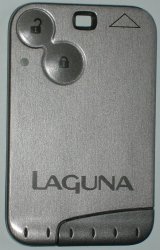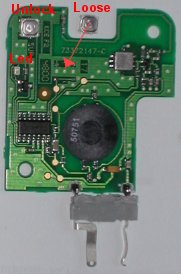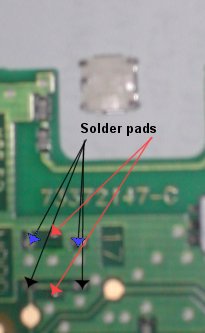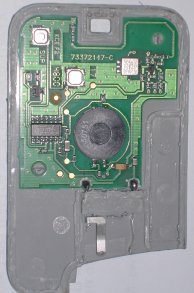A common fault with these keys is that one of the buttons stops working. You can tell when this is a fault with the key rather than the car because the led stops flashing. If both buttons have failed then first try the obvious and test the battery and make sure the contacts are clean. If so then you need to resort to one of two drastic solutions; buy another one (about £130) or repair it.

This is the type of key we are talking about, it is the type with two buttons and the safety slot in the end, not the proximity type. There may be other models that use a similar key, I have seen one with three buttons for instance, but I don’t know if they have the same weakness. The fault with these keys is that they use surface mount micro-switches and the “lock” one seems to be on a vulnerable part of the board which perhaps flexes and it drops off. Often you can hear it rattling loose inside.
The tools you will need are a good strong Stanley knife, a soldering iron with a very small tip (1mm or less), some long or curved-nose pliers, a strong magnifier and some super-glue.
The first task is to get inside. These are not clip-together cases, they are glued all round and on some internal ribs as well. On the photograph of my one below (click for a larger image without my annotations), I have marked the glue lines in red. The blue dots are unglued guide posts. With a strong Stanley knife and starting at the point marked “A” you can carefully cut along the edge, try to cut if you can as it doesn’t split very well—and watch your hands as the blade is liable to slip. When you reach the first bend “B” go back and do the first internal rib, then you can move round peering in the crack to see what to cut next. Be careful not to damage the components or the circuit board. A close inspection of the pictures shows the things to avoid, it is really a matter of patience, care and brute force.
As you can see, mine opened upside down, so the next step is to cut under the battery clip to separate the circuit from the case; I used a small kitchen knife to get in there.

So you should now have all the parts laid out including a loose button switch. This switch has a contact on each corner, two fold-under lugs to hold it together and two other lugs to help it stick to the board (ha! ha!). Sorry, the resolution of our camera is not good enough to see this detail. Near the centre of the circuit board you have a corresponding space with two pads on the earth plane at the top (arrowed blue), two on a track leading to the IC at the bottom (arrowed black) and two isolated holding pads (arrowed red). The orientation of the switch is important, the wrap around lugs MUST be to the sides.

With your fine tip soldering iron, clear up and tin all the contacts on the switch. Similarly clean the circuit board pads. You are well away from any delicate components here so there is not a lot of risk. Make a small solder bead on each pad. When I say small I mean small; I used a jewellers eyepiece to see what I was doing, scary with a hot soldering iron inches from my face.
Now lay the switch on top and test that it works by holding the battery in, and pressing the button. If you get the switch the wrong way around, the light will be on without pressing the button. Satisfied that it works you can solder the switch into place—holding the switch down with long pliers, touch the soldering iron to each corner and the top/bottom edges to get the solder to bridge the gap in six places. You may need to go round more than once as the component beds down to the surface. Test it again. As a final touch, I dribbled a bit of super-glue under the switch as an attempt to hold it more securely.
Now clean up the plastic parts with a knife, removing all loose bits and get the halves to mate together tightly without the circuit. You will also need to clean up the plastic part of the battery clip. Lay the circuit into the back cover, there should be two positioning pegs to hold it in place. Apply a drop of glue to the battery clip to secure it and leave it for a few moments to set. Finally run a bead of glue around the outside edges and the main internal rib, bring the parts together and clamp (clothes pegs) or weight it until it sets. How many of the original lines you do depends on if you are likely to want to undo it again but I would suggest omitting the front of the battery clip.
For the technical, the numbers on the components are: the big round piece (transmitter coil?) is 50751, the DIL package (encoder?) is Phillips PCF7947AT with other numbers 16793102 and DnD00350. The small silvery unit (oscillator crystal?) has EPC05, R727 and M5MN. A Google search didn’t turn up much.








 Webmaster
Webmaster
Cheers Henry good to know, Must add from my comment 119 that i also put one pin head blob of epoxy resin at the centre underneath the switch before replacing it for added adhesion many thanks.
Dear Rick, thanks for this helpful site. I opened up the keycard, when it failed to lock and re-soldered the microswitch. The door locks now work (but temporamentally) However it won’t now start the car! I did leave the battery out overnight, while the glue set. Could that have caused a problem, or have I damaged it when opening / soldering it? John
Hi John, I can only think you must have damaged something. I have never quite known what is used to start the car. It feels like it ought to be an RFID type circuit but I can’t see where it could be on the board. It has to be passive and independent of the door opening system.
Can anyone say me where I can order the button switches. By opening the keycard I dammage the unlock-switch!!
Regardsz
Dizze
FYI the black circular piece in the middle of the circuit board is the RFID transponder used to identify the keycard.
Thanks GP – I was coming to that conclusion as there was no other way it could work. It is presumably unpowered. What remains unclear is whether the code on the transponder takes any part in the door opening mechanism, it does appear to be electrically connected. I presume the thin track going around the top right is the transmitter aerial.
Hi Mate,
How much would you charge to get my card key repaired?
regards
p
Hello
Can you tell me where I can order for one of te two schwitches??
With kindly regards
P.Kraaijeveld
I’m off to have my keycard repaired with a company in Palmers Green, they charge £25 for 2 button and £30 for a three button.
I’ll let you know the out come next week.
Where in the UK can i get my Keycard repaired ?
Yours Sincerly Big Dave.
Hi Dave, there are suggestions in some of the other comments on this page. This post have become incredibly popular so there are rather a lot of them. Must be related to the Laguna getting old now.
hi my son has just bought me a renault laguna 1.6, with this he got 2 key fobs, one worked the other needed a battery, now both dont work, where and how much could i get another one from….
thanks
Debbie x
Hi Debbie, when you say they don’t work – I presume that they still start the car OK – that is a passive and completely independent operation.
As for opening the doors – you can unlock the doors on the passenger side using the manual key but to replace the remote control is expensive by the official means. If they don’t work because the buttons have dropped off then you will find places that repair them in the comments above
Hi, Im trying to fix my laguna key card, but ive noticed im missing some smd resistors. Would anyone be able to tell me what size resistor I need?
Just in case anyone is wanting this service done at a reasonable price, I am the cheapest on Ebay at £18.49.
Just search for “Renault Laguna Button Fault / Key Card Fix / Repair” and feel free to check out my hundreds of positive feedback.
MrSporty
[Edit by Rick – I can’t vouch for the services of MrSporty but if you want to use them he can be found at http://myworld.ebay.co.uk/mrsporty/ – curious that the photograph of the dismantled card that he uses on his listings was copied from my site!]
hello, Mr Sporty, I would like to use tour offer about key card. But I coul not find You in e-bay. How can I contact You?
Appologies for the blatant plagarism of your picture Rick. I will replace it on my next listing renewal with one of my own if you so wish.
Just a little addition to your technical notes if its of any interest. The “small silvery unit” is an EPCOS R727 1 Port SAW resonator, used to generate the 433.92Mhz radio signal for the remote portion of the card.
The PCF chip is the heart of the card. It is a dual mode Hitag2 transponder with the capabilites of being used as a crypto rfid and a code hopping transmitter.
MrS
I have read several comments and following question has been asked several times but I have not come accross the answer and that is: where can I buy/order these micro switches? I live in Holland and searching the internet for “switches” or “microswitches” did not help much.
Please advise where to go to. Thanks!
They are generally referred to as “Surface mount tactile switches”
reading point 133 you said about you can unlock by the passengers side by the manual way…but that seems to only contol that door?? have i got more problems than i thought?